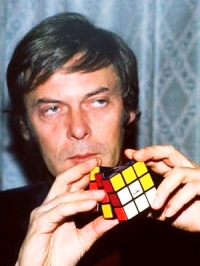Rubik Ernő, the inventor of the Magic Cube
The inventor of the Rubik’s cube (1974),Rubik’s
Magic, Rubik’s magic: Master Edition , Rubik’s Snake and Rubik’s 360 , Rubik Erno was born in 1944 during World War II. He is a Hungarian inventor, architect and professor of architecture.

He graduated from the Technical University, Budapest Faculty of Architecture in 1967 and began postgraduate studies in sculpting and interior architecture. From 1971 to 1975 he worked as an architect, then became a professor at the Budapest College of Applied Arts.
In the early 1980s, he became editor of a game and puzzle journal called …És játék (…And games), then became self-employed in 1983, founding the Rubik Stúdió, where he designed furniture and games. In 1987 he became professor with full tenure; in 1990 he became the president of the Hungarian Engineering Academy. At the Academy, he created the International Rubik Foundation to support especially talented young engineers and industrial designers.
At present he is mainly working on video game development and architectural topics and is still leading the Rubik Studios.
He is known to be an introvert, barely accessible and hard to contact or to get hold of for autographs. He typically does not attend speedcubing events. He also gave a lecture and autograph session at the “Bridges-Pecs” conference in July, 2010
However many Rubiks replicas have been sold, in the 80’s he was the richest people in Hungary.
Hungarian inventions
There are many world famous Hungarian inventions but a lot of them wasn’t patented in time or the Hungarian inventor lived in a foreign country. The reason why Hungarians are so proud of Rubik Erno is because he has always lived in Hungary and didn’t let someone else steal his invention.
Among the most famous Hungarian inventions we have to mention the non-explosive match (Irinyi János), Vitamin C (Szent-Györgyi Albert), Dynamo (Jedlik Anyos), Ballpoint Pen (Bíró László József), Hydrogen bomb (Teller Ede), Holography (Gabor Dénes), Computers, with linear programming (Neumann János), Soda water (Jedlik Ányos), Telephone exchange (Theodore Puskas), Torpedo (Luppis János), Water-cooled Reactor (Wigner Jeno)
No comments:
Post a Comment